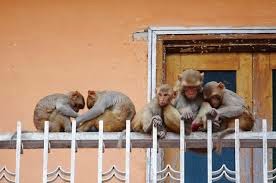I returned to Varanasi at 5 o'clock, and walked along the River Ganges (pronounced Ganga) where hundreds of people were already gathering on the steps of the Dashashwameda ghat for the ancient Aarti ceremony. The Ganges is considered the most sacred river in India. It is where Hindus come to wash away bad Karma and escape the wheel of samsara. At the ceremony Hindu pujaris (priests) and students of the Vedas and Upanishads offer evening prayers every night at 6:45 pm. I heard the beautiful sound of Vedic mantras being chanted through loudspeakers. There were women in colorful saris immersing themselves in prayer in the sacred Ganges, and bearded men in brightly colored dhoti loin cloth, with painted faces. They are "holy men" (sadhus) in their fourth stage of life who renounce all signs of caste, and possessions. Some of the holy men may have been Aghori's, which is an esoteric Hindu sect.
There were cows, and dogs wandering everywhere, and dung on the ground. I stepped on one and yelled "shit." A man next to me laughed and said, "No big deal, it's only cow dung." Monkeys were clinging to the buildings. Young women were selling marigold flowers and candles for people to float in the river. It reminded me of when I lit candles in Catholic churches and offered a prayer. There were many beggars. It was hard to ignore them, but my guide told me not to respond to anyone, as some are dishonest. Americans are prime targets for and perceived as wealthy.

 |
| Holy man |
 |
| ascetics on the Dashashwamedh ghat |
 |
| Holy man (sadhu) |
 |
| Holy men |
 |
| Possibly an Aghori sadhu |
There were hundreds of rickety boats carrying people out onto the river to watch the ceremony.
 |
| Holy men along the Ganges
There was a flotilla of hundreds of boats filled with tourists taking photos of the ceremony.
|
 |
| Bathers in the holy Ganges |
Cremations ghat
Around 8:30 pm I walked to the Manikarnika cremation ghat. There are two cremation ghats on the river where about two hundred bodies are cremated all day and night. Nearby were hospices where people come here to die. It was dark so I was careful not to slip into the polluted Ganges River. I walked beside several bodies being cremated. It is considered the last rite of passage for Hindus. When a person is cremated in Varanasi their soul is liberated (Moksha) from reincarnation (Samsara). Cremation at the Ganges is considered by Hindus to be the holiest place on earth because the body's ashes can be sprinkles into the sacred river.
Not everyone is permitted cremation; pregnant women, infants, holy men, people bitten by snakes, people with leprosy, people who committed suicide, and poor who cannot afford cremation. The bodies are floated in the Ganges to decompose. I saw Brahmin's being cremated on the highest part of the ghat, while people of other castes were cremated on the lower sections.
Aarti ceremony
I returned to the Dashashwameda ghat to watch more of the religious Aarti ceremony, where I stayed till the very end at 9 pm. I watched it from several angles. It was humbling to witness such reverence and faith.
I then returned to the Airtel kiosk to meet my guide, who led me through the city to get our car, and go back to the hotel.
Varanasi is chaotic; noisy cars, rickshaws, tuk-tuks, vegetable markets, cows and dogs wandering everywhere, garbage in the streets, shops selling postcards and religious items, food vendors. And its one of the holiest places in the world, saturated with history and human energy.
Around 8:30 pm I walked to the Manikarnika cremation ghat. There are two cremation ghats on the river where about two hundred bodies are cremated all day and night. Nearby were hospices where people come here to die. It was dark so I was careful not to slip into the polluted Ganges River. I walked beside several bodies being cremated. It is considered the last rite of passage for Hindus. When a person is cremated in Varanasi their soul is liberated (Moksha) from reincarnation (Samsara). Cremation at the Ganges is considered by Hindus to be the holiest place on earth because the body's ashes can be sprinkles into the sacred river.
Not everyone is permitted cremation; pregnant women, infants, holy men, people bitten by snakes, people with leprosy, people who committed suicide, and poor who cannot afford cremation. The bodies are floated in the Ganges to decompose. I saw Brahmin's being cremated on the highest part of the ghat, while people of other castes were cremated on the lower sections.
I returned to the Dashashwameda ghat to watch more of the religious Aarti ceremony, where I stayed till the very end at 9 pm. I watched it from several angles. It was humbling to witness such reverence and faith.
I reunited with the young girls from Puerto Rico and PA who I had met a few cities ago. Westerners visiting India like sharing their experiences with other westerners.
Varanasi is chaotic; noisy cars, rickshaws, tuk-tuks, vegetable markets, cows and dogs wandering everywhere, garbage in the streets, shops selling postcards and religious items, food vendors. And its one of the holiest places in the world, saturated with history and human energy.












No comments:
Post a Comment